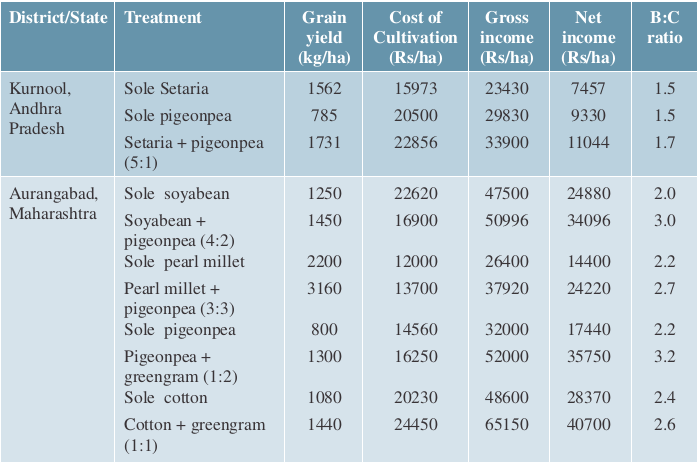Crop diversification for livelihood security and resilience to climate variability
Crop diversification for livelihood security and resilience to climate variability
Climate Vulnerability
Drought/heat wave, frost/cold wave and floods
Existing practice
In scarce rainfall zones of India, practice of sole cropping is predominant but is risky and often results in low yields or sometimes even in crop failure due to erratic monsoon rainfall and skewed distribution. In such areas intercropping is a feasible option to minimize risk in crop production, ensure reasonable returns at least from the intercrop and also improve soil fertility with a legume intercrop. Cotton, soybean, pigeonpea and millets are the major crops in the scarce rainfall zones. Intercropping of these crops is more profitable and is a key drought coping strategy.
Resilient Practice / technology
Pigeonpea, cotton, sunflower and sorghum are the main crops cultivated in NICRA village in Kurnool district, Andhra Pradesh which are affected due to late onset of monsoon followed by dry spell at critical crop growth stages. Intercropping of Setaria (foxtail millet, SIA-3085 variety) with pigeonpea (5:1 ratio) sown in July showed that the intercropping system was more profitable with highest benefit cost ratio in all the 3 years despite prolonged dry spell of up to 25 days in 2012. Intercropping of soybean + pigeonpea (4:2), pearlmillet + pigeonpea (3:3), pigeonpea + green gram (1:2) and cotton + green gram (1:1) performed significantly better than their sole crops at Aurangabad, Maharashtra. Similarly, demonstrations on crop diversification by inclusion of HYVs of black gram, sesamum, gobhi sarson, gram, lentil, toria and okra were conducted in Said-Sohal village in Kathua district of Jammu and Kashmir.
Impact of crop diversification
Farmers in Yagantepalli village, Kurnool district took up sole and intercrops of Setaria and pigeonpea for 3 years in this predominantly rainfed village (70%). Performance of the intercropping system of Setaria + pigeonpea (5:1) gave the highest benefit cost ratio ranging from 1.7 to 3.1 compared to the sole crops of Setaria and pigeonpea (1.5 to 2.6). At Shektha village, Aurangabad, Maharashtra farmers realized the advantage of higher net incomes with intercropping of the main crops such as cotton, pearlmillet, pigeonpea and soybean ranging from Rs.9216 to Rs.12330/ha.

In Kathua district of Jammu & Kashmir, results of demonstrations on high yielding varieties (HYVs) of maize showed 81.4% increase over traditional cultivar. Demonstrations on crop diversification by inclusion of HYVs of black gram, sesamum, gobhi sarson, gram, lentil, toria and okra resulted in a yield increase to the tune of 62.5, 62.8, 51.3, 96.8, 76.5, 88.4 and 38.1%, respectively over traditionally grown varieties. In maize + cowpea intercropping, due to synergy existing between two intercrops, an yield enhancement of 75.3% in maize and 2.3% in cowpea was observed over the traditional system with a net return of Rs. 24200/ha in maize and Rs. 32400/ha in cowpea. Net return in case of cowpea was more because, no additional input other than seed was applied to the cowpea crop.


Scale of demonstration
Inter cropping was demonstrated in 2654 ha covering 2033 farmers in Kathua (Jammu & Kashmir); Hamirpur, Chamba (Himachal Pradesh); Ropar (Punjab); Saran, Jehanabad, Supaul (Bihar); Sonitpur, Dhubri (Assam); Sonepur, Kendrapara (Odisha); Dantewada, Bilaspur (Chhattisgarh); Gondia, Amravati, Aurangabad (Maharashtra); Kushinagar, Chitrakoot (Uttar Pradesh); Kutch, Valsad (Gujrat); Satna, Datia (Madya Pradesh); Nalgonda, Anantapur (Andhra Pradesh); Davangere (Karnataka) and Nammakal (Tamil Nadu) with an yield advantage ranging from 10.5 to 85.2% and benefit cost ratio of 1.3 to 4.2 compared to farmers’ practice.
Introduction of drought tolerant variety of bottle gourd in rainfed condition: Gondia
Rice is a major crop grown during kharif in Katangtola and Chandanitola villages in Gondia district. Farmers incur facing high cost of production and low remuneration from rice cultivation. Hence, drought tolerant variety (Warad) of bottle gourd crop was introduced as an alternate crop to rice along with micro- irrigation system. The crop was sown in the first week of June 2012 in 0.35 ha and the net income was Rs. 33,500 by cultivation of bottle gourd whereas with rice crop it was only Rs. 7,500/ha. Most of the farmers from nearby villages visited the demonstration plot and eight farmers came forward and started cultivating vegetable crops by using drip irrigation by availing subsidy from the state department of agriculture, Maharashtra.

Scope for Upscaling
Crop diversification including intercropping of rainfed crops is an important risk minimizing strategy for drought proofing in the scarce rainfall zones and paddy growing areas. In contingency situations such as delay in onset of monsoon, adoption of intercropping for delayed plantings can be remunerative instead of sole cropping. However, availability and access to farm implements for taking up the intercropping systems is to be ensured for wider adoption. In this context, village level custom hiring service centers for making available farm implements can help increase the adoption by small and marginal farmers in the states of Andhra Pradesh, Assam, Gujarat, Punjab, Himachal Pradesh, Meghalaya, Tripura, Jammu & Kashmir.
Source: Smart Practices and Technologies for Climate Resilient Agriculture
ಕೊನೆಯ ಮಾರ್ಪಾಟು : 2/13/2020
This topic provides information about Drought tole...
This topic provides information about Community ta...
This topic provides information about Captive rear...
This topic defines about the Enhancing resilience ...
